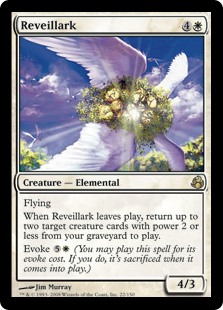Intellectual Offering — Tymna and Sidar

It’s that time again. This week on Intellectual Offering we are going back to IO's roots and examining a deck on a card-for-card basis. Ok, that’s a small lie. This week we examine a couple of decks that are all actually one. This week I’m looking at Tymna the Weaver and Sidar Kondo of Jamuraa, two legendary creatures that are fantastic together because they both don’t have commas in their names. That, and the synergy between the two is pretty high; Sidar granting all our smaller creatures unblockability means that we get more options to draw more cards off of Tymna, which in turn fuels further beatdowns. I think these two are underrated commanders so I’ve decided to take a look at the various ways people are using them in the hopes of sparking some fun discussion.
Swing Your Partner Round 'n Round

Let’s start by taking a look at the average Sidar and Tymna deck:
This isn’t something that we’ve done before in this series, so I’d like to take just a second to dive into what an average decklist actually means in terms of EDHREC. For this all I’ve done is click the option under the image of the commander “View average deck”. This generates a list based of the 100 most commonly played cards (commander(s) included) in the deck. This may seem intuitive, but it’s important to note that what this doesn’t do well is catch things that are commonly played, but exclusive to a certain build of the deck. This is more obvious if you were to try and take a commander like Atraxa, Praetors’ Voice and get an average list out of her, there would be cards for planeswalker-based superfriends decks right alongside things for +1/+1 counter theme decks. This issue will become relevant later on in the article, for now let’s just assume there’s no overlapping strategies in this list and use it as our baseline for commentary.

Right away there are things worth noting. Players are clearly attempting to maximize on Sidar’s ability to grant unblockability, with only a couple of very powerful inclusions above the 2 power mark: Sun Titan and Reveillark. The deck also plays around the theme in other ways, including powerhouses like Immortal Servitude and Dawn // Dusk to reanimate mass amounts of hatebears without the drawbacks of other mass-reanimation spells like Living Death that can also help opponents. The deck has a very minor sacrifice theme, and plays only Zulaport Cutthroat, which I do find strange given that both Blood Artist and Falkenrath Noble fall in the deck’s intended strategy. Artist just misses the cutoff for average inclusion at 21% but Noble lags behind wildly with only 5% inclusion rate, which seems like a strange disparity to me. While the Artist wouldn’t do much in the way of combat, it would also help punish Wrath of God effects that are generally devastating to aggressive strategies like this one. The average player is also missing out on some powerful redundancy in the form of Bygone Bishop, which misses the cut at only 18% inclusion. I personally find Bishop to be better than Mentor of the Meek (which has 46% inclusion rate) as it lets you pay for cards in installments rather than all at once. The argument that you miss out on some triggers as it needs to be cast (versus enters the battlefield) and that Bishop checks CMC versus power is nonsense to me as only 4/35 creatures in the average deck have CMC > 3. Additionally I am surprised by the complete lack of creature-based creature removal in the above list. That means that the average player is relying on exactly four instants to deal with the majority of creature-based issues. In a deck that is so heavily themed on creatures I would expect to at least see something like a Nekrataal at the very least.

Since this deck likes playing small creatures, the obvious path for this is finding hatebears that can set our opponents back while not affecting our plans. The average deck includes a great number of such creatures, cards like Gaddock Teeg, Thalia, Guardian of Thraben, and Aven Mindcensor all make perfect sense in this list. On the flip side, there is a card I am surprised to see is Hushwing Griff. This card turns off a lot of the utility in this deck, including the extremely powerful Aura Shards. I feel like this needs to be built around more than it is in an average list to be effective. Even while it may be turning off more of an opponents’ cards than your own, it almost completely cuts off the deck’s access to utility effects and could very easily backfire. On a similar note, the inclusion of, by my count, six mana dorks is really high. The average converted mana cost (CMC) of the average deck is only 2.49. This is very agressive and 5 mana dorks feels like there is plenty of room for improvement here.
Logical Extreme

Now what I’d like to do is examine this deck in a different light. What if we went so far into the theme that we actually came out the other side on a different one? What if we took a commander known for loving small creatures, and added it to the list as a “Jack-in-the-Box” commander. (All credit for this name goes to the awesome crew over on the Commander Cookout podcast, so check ‘em out. Warning: explicit content.) I’m talking about Shirei, Shizo’s Caretaker. This requires us to build our deck almost entirely out of creatures with power 1 or less. As many of the creatures as possible should meet this condition. What would a deck like this look like? Here’s my take on such a list:
|
I tried to include effects that maximize the hidden commander, other recursion including an old favorite Proclamation of Rebirth, and specialized tutors like Antoine Ruel himself (aka Ranger of Eos.) Then, wherever possible I tried to use a 1-power creature to represent a specific effect I want. Cards like Ruin Rat and Heap Doll are tutor-able graveyard hate, while cards like Caustic Catapillar and Harmonic Sliver deal with the messy artifacts and enchantments. I still left a personal favorite card, Sylvan Reclamation in there on the high end of the curve as it can be basic landcycled as necessary and sometimes you just need to exile some indestructible stuff. While I am not a huge fan of tutors, I included a couple flavorful ones that also let us sacrifice creatures in the form of Diabolic Intent and Razaketh, the Foulblooded since we are trying to find our third commander, and when we do have Shirei in play their downsides are negated and we can tutor to our heart’s content. I avoided what I would call "frivolous" sac outlets such as Ashnod's Altar as we wouldn't really have anything to spend the mana on.
So why would one build a deck like this? You are maximizing the impact of a card, certainly. In deckbuilding, especially in EDH, we always want to pick the optimal, usually maximized route. In this case I wouldn't argue that this list is necessarily better than the average list (assuming we tuned the list as equally as I'd tuned this one). For one thing it will certainly struggle to get there more than the original list simply because all of your creatures have half of their potential (maximum) power. I've also attempted to mitigate this by including a higher quantity of token producers, and even the low-CMC doublers, as the tokens they create stick around even after we've sacrificed the original creature, and begin to accumulate when Shirei is in play. The addition of tokens does help this version go slightly wider in the end, and since "tall" for the average deck is two power, I'd argue that this is an advantage. The other major, for me at least, upside to taking a list to the extreme like this is it adds tons of originality. I've seen plenty of arguments that EDHREC is "killing the format" but I'd argue it's the exact opposite. How else would I be able to build what I can statistically determine to be a completely original deck, while still using the power of crowd-sourced data to drive informed inclusions?
Impossible Truth

Speaking of informed inclusions, while making our original brew we can apply a filter for a card we would believe to only be included in decks similar to ours, say for example Shirei himself, and see what we get. When we do the top card becomes Shadowborn Apostle (SBA) with 100% inclusion in 4 decks. Interesting. So some people have had this idea, but put it together using SBAs as the operative creature instead of generalizing on Shirei. What if we filter based on just Proclamation of Rebirth? This card should only be in lists similar to those I’ve suggested above, and should have high correlation to them as it’s easy to find with a gatherer advanced search for things that care about 1 power. Sadly this gets us only 2 decks, and they’re both SBA lists. A fun concept to be sure. If I had to postulate what their decks looked like, based on the top inclusions, I’d guess something like this:
|
Cute, but not really my cup of tea. I prefer to have my decks not be too one-trick-pony and this deck screams that to me.

it's a good trick though!
Lessons Learned?
With all that said what have we learned? Well first off there’s always more to be gleaned from the data on EDHREC. Had we not implemented the Shirei filter on Sidar and Tymna we wouldn’t have seen the SBA deck that has been brewed around it. We also learned that sometimes it’s hard to read between the lines of the data, even filtering with a card that should theoretically represent the deck we’re building we don’t get what we want (or, less likely, we are the first person to come up with the idea).
Thanks for reading and leave your comments, or if you have a recommendation for a deck to do an offering on, leave those comments below. Until next time!
EDHREC Code of Conduct